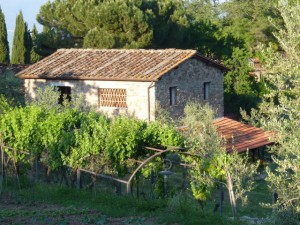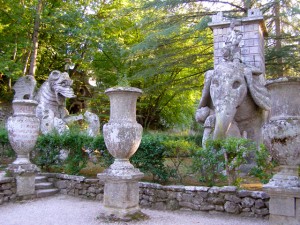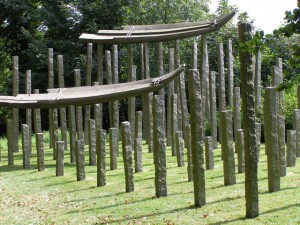So What ISISISIS A Garden?

Aldeburgh town, in the Empty Quarter of Suffolk, and on threat of being sucked into the waters of the North Sea, is no everyday resort. Pole down the road across the marshes, past the flagged-up golf club and the brown mass of the sea drapes itself in front of you. A massive expanse of shingle stops the water lapping at the houses, two rows deep. Gulls shriek round the fish and chip queue. The place is rigid with retired grandees and smoothed with the jetsam of culture. The Met regularly beams to the cinema, dizzying quantities of art revolve through the galleries and most niche of all, there is The Aldeburgh Literary Festival.
This lasts for a weekend. A small and rather old fashioned leaflet comes out and those who do not turn their ticked-box applications around in a flash will not get into any of the events. Do not rely on the postman and the internet is out of the equation. Drive straight round and get your envelope onto the doormat before Monday morning. I’ve signed up for William Sieghart with Rosie Boycott on “Winning Words: Inspiring Poems for Everyday Life” and “What are Gardens For?” with Rory Stuart.
At the time it seemed like a gesture of horti solidarity. Hours upended in flowerbeds, breathing-thinking-sleeping gardens. I know what a garden is for. Or did : since ticking the box, disquiet has crept in. Gnarly gardeners’ fingers on the steering wheel, throwing up a ponder. I know it is more than a place to hang the washing............ what is a garden for?
What indeed? What? What?What is a garden? A long and not entirely crisp musing has begun. Must think it through before turning up to Mr Rory’s lecture and gamma-hoovering up his views. So what is garden? It is outside, for starters. But when is an outdoor space even a garden at all?

Last May found me in Tuscany: a happy and lazy month above the Arno in Borgo di Casignano. Wwoofing on a farm, I was given the job of preparing the garden for a family wedding. The garden? the same old olive trees as everywhere else on those Arno hills. Exception here was that the grass beneath was shorn and a good deal of grooming by rake went on. Dry stone walled off from rude farming. So does enclosure define one?
To Jarman’s Dungeness garden. Unfenced. A rearrangement of pebbles, found objects and the silhouette of a power station with marching band of telegraph poles. Jarman has personalised a little bit of the infinite space. Is his space a garden?
Take the branch-line train in Italy, and you will see the space higgledy-pig by the track turned over to tomatoes and a few vines. This is like an allotment. Is an allotment a garden? Think not, but why not?
A telescopic gallop through the gardens of the ancients has the celebration of water and shelter from the harsh elements. From the Egyptians with doum palms and papyrus fronding the canals, to the mughal gardens of Kashmir, water is sacred. The cool playgrounds of the Dal valley had myriads of gardens of fountains, cascades and rills reflecting mountain peaks. Empty concrete basins and weedy lawns are all that is left. Moghul miniatures give a glimpse that is brought to life at the Alhambra in Granada, Spain.
[caption id="attachment_2347" align="alignleft" width="300"]

Il Sacro Bosco[/caption]
A garden as an enclosure with paradise within. The Garden of Eden is a common strand in judaism, islam and christianity. From the Song of Solomon in the Old Testament we have: “A garden locked is my sister, my bride: a garden locked, a fountain sealed”. There is a link-up with purity, virginity and the Madonna. This sees a shift from the profane to the sacred. A retreat and a refuge.
And then there are gardens as green memorials. A place to come and contemplate as is Shah Jahan’s monument to his wife Mumtaz: The Taj Mahal. A private space made public. Another and completely different memorial is Sacro Bosco in Lazio, Italy. A garden of monsters tumbling about in the bottom of a ravine below the Sabine Hills. This crazy mannerist writhing place was also to commemorate a deceased wife.
Close to a memorial in meaning but not always overlapping is the garden of contemplation. Zen-inspired gardens shrink the scale of the natural world. The miniature landscape is carefully arranged to make a place for meditation. I think of the stillness of one perfectly poised stone on a bed of gravel. Calmness exudes.
It is a far a cry from here to the waterworks constructed on the command of the Salzburg Prince Archbishop at Hellbrun, at Villa Lante for Francesco Gambara or at Villa d’Este for Ippolito d’Este. (The latter two are cardinals.) These are gardens for amazing the guests. Lutes of water flow down hills, there are stone tables with watery centres for keeping the white wine chilled and jets of water to spray up between the stone seats. Man has totally tamed the landscape, bent it to his will, mastered the elements. These are party gardens. There is a possibility of tipping into the brashest of showing off.
[caption id="attachment_2346" align="alignleft" width="300"]

Cass Foundation[/caption]
Gardens for collectors are usually very attractive. With the placing of site specific art or the sale of gorgeous uncommissioned pieces. Roche Court or Cass Foundation in this country are fabulous places to wander. I am pretty sure you can buy anything here but meanwhile Gormley jugglers play against beech woods, the slate of Richard Long flows riparian down the hill. But seldom do collections of plants achieve the same aesthetic. Think of the botanising beds in Oxford Botanic Gardens. The giant cacti of Cesar Manrique’s moonscape in Lanzarote do make a garden. But why?
And then there is inspiration or stage. Claude Monet was an expert gardener and at Givenchy he grew what he wanted to paint. His canvases became larger and larger taking a ever more microscopic view. Friends with the French PM, his titanic water lily series was set up after the first World War as an installation to celebrate the Peace. Jarman used his garden for filming. His opus ‘The Garden‘ is a challenge but he like Monet used his garden to create art.
My weak conclusion is that is whatever the hell you wish it to be. The place for the ultimate flamboyant self expression. But the washing line of my mind is nagging me: how does the small suburban garden fit into all of this? I am looking forward to enlightenment.
 Aldeburgh town, in the Empty Quarter of Suffolk, and on threat of being sucked into the waters of the North Sea, is no everyday resort. Pole down the road across the marshes, past the flagged-up golf club and the brown mass of the sea drapes itself in front of you. A massive expanse of shingle stops the water lapping at the houses, two rows deep. Gulls shriek round the fish and chip queue. The place is rigid with retired grandees and smoothed with the jetsam of culture. The Met regularly beams to the cinema, dizzying quantities of art revolve through the galleries and most niche of all, there is The Aldeburgh Literary Festival.
This lasts for a weekend. A small and rather old fashioned leaflet comes out and those who do not turn their ticked-box applications around in a flash will not get into any of the events. Do not rely on the postman and the internet is out of the equation. Drive straight round and get your envelope onto the doormat before Monday morning. I’ve signed up for William Sieghart with Rosie Boycott on “Winning Words: Inspiring Poems for Everyday Life” and “What are Gardens For?” with Rory Stuart.
At the time it seemed like a gesture of horti solidarity. Hours upended in flowerbeds, breathing-thinking-sleeping gardens. I know what a garden is for. Or did : since ticking the box, disquiet has crept in. Gnarly gardeners’ fingers on the steering wheel, throwing up a ponder. I know it is more than a place to hang the washing............ what is a garden for?
What indeed? What? What?What is a garden? A long and not entirely crisp musing has begun. Must think it through before turning up to Mr Rory’s lecture and gamma-hoovering up his views. So what is garden? It is outside, for starters. But when is an outdoor space even a garden at all?
Aldeburgh town, in the Empty Quarter of Suffolk, and on threat of being sucked into the waters of the North Sea, is no everyday resort. Pole down the road across the marshes, past the flagged-up golf club and the brown mass of the sea drapes itself in front of you. A massive expanse of shingle stops the water lapping at the houses, two rows deep. Gulls shriek round the fish and chip queue. The place is rigid with retired grandees and smoothed with the jetsam of culture. The Met regularly beams to the cinema, dizzying quantities of art revolve through the galleries and most niche of all, there is The Aldeburgh Literary Festival.
This lasts for a weekend. A small and rather old fashioned leaflet comes out and those who do not turn their ticked-box applications around in a flash will not get into any of the events. Do not rely on the postman and the internet is out of the equation. Drive straight round and get your envelope onto the doormat before Monday morning. I’ve signed up for William Sieghart with Rosie Boycott on “Winning Words: Inspiring Poems for Everyday Life” and “What are Gardens For?” with Rory Stuart.
At the time it seemed like a gesture of horti solidarity. Hours upended in flowerbeds, breathing-thinking-sleeping gardens. I know what a garden is for. Or did : since ticking the box, disquiet has crept in. Gnarly gardeners’ fingers on the steering wheel, throwing up a ponder. I know it is more than a place to hang the washing............ what is a garden for?
What indeed? What? What?What is a garden? A long and not entirely crisp musing has begun. Must think it through before turning up to Mr Rory’s lecture and gamma-hoovering up his views. So what is garden? It is outside, for starters. But when is an outdoor space even a garden at all?
 Last May found me in Tuscany: a happy and lazy month above the Arno in Borgo di Casignano. Wwoofing on a farm, I was given the job of preparing the garden for a family wedding. The garden? the same old olive trees as everywhere else on those Arno hills. Exception here was that the grass beneath was shorn and a good deal of grooming by rake went on. Dry stone walled off from rude farming. So does enclosure define one?
To Jarman’s Dungeness garden. Unfenced. A rearrangement of pebbles, found objects and the silhouette of a power station with marching band of telegraph poles. Jarman has personalised a little bit of the infinite space. Is his space a garden?
Take the branch-line train in Italy, and you will see the space higgledy-pig by the track turned over to tomatoes and a few vines. This is like an allotment. Is an allotment a garden? Think not, but why not?
A telescopic gallop through the gardens of the ancients has the celebration of water and shelter from the harsh elements. From the Egyptians with doum palms and papyrus fronding the canals, to the mughal gardens of Kashmir, water is sacred. The cool playgrounds of the Dal valley had myriads of gardens of fountains, cascades and rills reflecting mountain peaks. Empty concrete basins and weedy lawns are all that is left. Moghul miniatures give a glimpse that is brought to life at the Alhambra in Granada, Spain.
[caption id="attachment_2347" align="alignleft" width="300"]
Last May found me in Tuscany: a happy and lazy month above the Arno in Borgo di Casignano. Wwoofing on a farm, I was given the job of preparing the garden for a family wedding. The garden? the same old olive trees as everywhere else on those Arno hills. Exception here was that the grass beneath was shorn and a good deal of grooming by rake went on. Dry stone walled off from rude farming. So does enclosure define one?
To Jarman’s Dungeness garden. Unfenced. A rearrangement of pebbles, found objects and the silhouette of a power station with marching band of telegraph poles. Jarman has personalised a little bit of the infinite space. Is his space a garden?
Take the branch-line train in Italy, and you will see the space higgledy-pig by the track turned over to tomatoes and a few vines. This is like an allotment. Is an allotment a garden? Think not, but why not?
A telescopic gallop through the gardens of the ancients has the celebration of water and shelter from the harsh elements. From the Egyptians with doum palms and papyrus fronding the canals, to the mughal gardens of Kashmir, water is sacred. The cool playgrounds of the Dal valley had myriads of gardens of fountains, cascades and rills reflecting mountain peaks. Empty concrete basins and weedy lawns are all that is left. Moghul miniatures give a glimpse that is brought to life at the Alhambra in Granada, Spain.
[caption id="attachment_2347" align="alignleft" width="300"] Il Sacro Bosco[/caption]
A garden as an enclosure with paradise within. The Garden of Eden is a common strand in judaism, islam and christianity. From the Song of Solomon in the Old Testament we have: “A garden locked is my sister, my bride: a garden locked, a fountain sealed”. There is a link-up with purity, virginity and the Madonna. This sees a shift from the profane to the sacred. A retreat and a refuge.
And then there are gardens as green memorials. A place to come and contemplate as is Shah Jahan’s monument to his wife Mumtaz: The Taj Mahal. A private space made public. Another and completely different memorial is Sacro Bosco in Lazio, Italy. A garden of monsters tumbling about in the bottom of a ravine below the Sabine Hills. This crazy mannerist writhing place was also to commemorate a deceased wife.
Close to a memorial in meaning but not always overlapping is the garden of contemplation. Zen-inspired gardens shrink the scale of the natural world. The miniature landscape is carefully arranged to make a place for meditation. I think of the stillness of one perfectly poised stone on a bed of gravel. Calmness exudes.
It is a far a cry from here to the waterworks constructed on the command of the Salzburg Prince Archbishop at Hellbrun, at Villa Lante for Francesco Gambara or at Villa d’Este for Ippolito d’Este. (The latter two are cardinals.) These are gardens for amazing the guests. Lutes of water flow down hills, there are stone tables with watery centres for keeping the white wine chilled and jets of water to spray up between the stone seats. Man has totally tamed the landscape, bent it to his will, mastered the elements. These are party gardens. There is a possibility of tipping into the brashest of showing off.
[caption id="attachment_2346" align="alignleft" width="300"]
Il Sacro Bosco[/caption]
A garden as an enclosure with paradise within. The Garden of Eden is a common strand in judaism, islam and christianity. From the Song of Solomon in the Old Testament we have: “A garden locked is my sister, my bride: a garden locked, a fountain sealed”. There is a link-up with purity, virginity and the Madonna. This sees a shift from the profane to the sacred. A retreat and a refuge.
And then there are gardens as green memorials. A place to come and contemplate as is Shah Jahan’s monument to his wife Mumtaz: The Taj Mahal. A private space made public. Another and completely different memorial is Sacro Bosco in Lazio, Italy. A garden of monsters tumbling about in the bottom of a ravine below the Sabine Hills. This crazy mannerist writhing place was also to commemorate a deceased wife.
Close to a memorial in meaning but not always overlapping is the garden of contemplation. Zen-inspired gardens shrink the scale of the natural world. The miniature landscape is carefully arranged to make a place for meditation. I think of the stillness of one perfectly poised stone on a bed of gravel. Calmness exudes.
It is a far a cry from here to the waterworks constructed on the command of the Salzburg Prince Archbishop at Hellbrun, at Villa Lante for Francesco Gambara or at Villa d’Este for Ippolito d’Este. (The latter two are cardinals.) These are gardens for amazing the guests. Lutes of water flow down hills, there are stone tables with watery centres for keeping the white wine chilled and jets of water to spray up between the stone seats. Man has totally tamed the landscape, bent it to his will, mastered the elements. These are party gardens. There is a possibility of tipping into the brashest of showing off.
[caption id="attachment_2346" align="alignleft" width="300"] Cass Foundation[/caption]
Gardens for collectors are usually very attractive. With the placing of site specific art or the sale of gorgeous uncommissioned pieces. Roche Court or Cass Foundation in this country are fabulous places to wander. I am pretty sure you can buy anything here but meanwhile Gormley jugglers play against beech woods, the slate of Richard Long flows riparian down the hill. But seldom do collections of plants achieve the same aesthetic. Think of the botanising beds in Oxford Botanic Gardens. The giant cacti of Cesar Manrique’s moonscape in Lanzarote do make a garden. But why?
And then there is inspiration or stage. Claude Monet was an expert gardener and at Givenchy he grew what he wanted to paint. His canvases became larger and larger taking a ever more microscopic view. Friends with the French PM, his titanic water lily series was set up after the first World War as an installation to celebrate the Peace. Jarman used his garden for filming. His opus ‘The Garden‘ is a challenge but he like Monet used his garden to create art.
My weak conclusion is that is whatever the hell you wish it to be. The place for the ultimate flamboyant self expression. But the washing line of my mind is nagging me: how does the small suburban garden fit into all of this? I am looking forward to enlightenment.
Cass Foundation[/caption]
Gardens for collectors are usually very attractive. With the placing of site specific art or the sale of gorgeous uncommissioned pieces. Roche Court or Cass Foundation in this country are fabulous places to wander. I am pretty sure you can buy anything here but meanwhile Gormley jugglers play against beech woods, the slate of Richard Long flows riparian down the hill. But seldom do collections of plants achieve the same aesthetic. Think of the botanising beds in Oxford Botanic Gardens. The giant cacti of Cesar Manrique’s moonscape in Lanzarote do make a garden. But why?
And then there is inspiration or stage. Claude Monet was an expert gardener and at Givenchy he grew what he wanted to paint. His canvases became larger and larger taking a ever more microscopic view. Friends with the French PM, his titanic water lily series was set up after the first World War as an installation to celebrate the Peace. Jarman used his garden for filming. His opus ‘The Garden‘ is a challenge but he like Monet used his garden to create art.
My weak conclusion is that is whatever the hell you wish it to be. The place for the ultimate flamboyant self expression. But the washing line of my mind is nagging me: how does the small suburban garden fit into all of this? I am looking forward to enlightenment. 